The NVIDIA GeForce GTX 780 Ti Review
by Ryan Smith on November 7, 2013 9:01 AM ESTOverclocking
Finally, let’s spend a bit of time looking at the overclocking prospects for the GTX 780 Ti. Although GTX 780 Ti is now the fastest GK110 part, based on what we've seen with GTX 780 and GTX Titan there should still be some headroom to play with. Meanwhile there will also be the matter of memory overclocking, as 7GHz GDDR5 on a 384-bit bus presents us with a new baseline that we haven't seen before.
| GeForce GTX 780 Ti Overclocking | ||||
| Stock | Overclocked | |||
| Core Clock | 876MHz | 1026MHz | ||
| Boost Clock | 928MHz | 1078MHz | ||
| Max Boost Clock | 1020MHz | 1169MHz | ||
| Memory Clock | 7GHz | 7.6GHz | ||
| Max Voltage | 1.187v | 1.187v | ||
Overall our overclock for the GTX 780 Ti is a bit on the low side compared to the other GTX 780 cards we’ve seen in the past, but not immensely so. With a GPU overclock of 150MHz, we’re able to push the base clock and maximum boost clocks ahead by 17% and 14% respectively, which should further extend NVIDIA’s performance lead by a similar amount.
Meanwhile the inability to unlock a higher boost bin through overvolting is somewhat disappointing, as this is the first time we’ve seen this happen. To be clear here GTX 780 Ti does support overvolting – our card offers up to another 75mV of voltage – however on closer examination our card doesn’t have a higher bin within reach; 75mV isn’t enough to reach the next validated bin. Apparently this is something that can happen with the way NVIDIA bins their chips and implements overvolting, though this the first time we’ve seen a card actually suffer from this. The end result is that it limits our ability to boost at the highest bins, as we’d normally have a bin or two unlocked to further increase the maximum boost clock.
As for memory overclocking, we were able to squeeze out a bit more out of our 7GHz GDDR5, pushing our memory clock 600MHz (9%) higher to 7.6GHz. Memory overclocking is always something of a roll of the dice, so it’s not clear here whether this is average or not for a GK110 setup with 7GHz GDDR5. Given the general drawbacks of a wider memory bus we wouldn’t be surprised if this was average, but at the same time in practice GK110 cards haven’t shown themselves to be as memory bandwidth limited as GK104 cards. So 9%, though a smaller gain than what we’ve seen on other cards, should still provide GTX 780 Ti with enough to keep the overclocked GPU well fed.
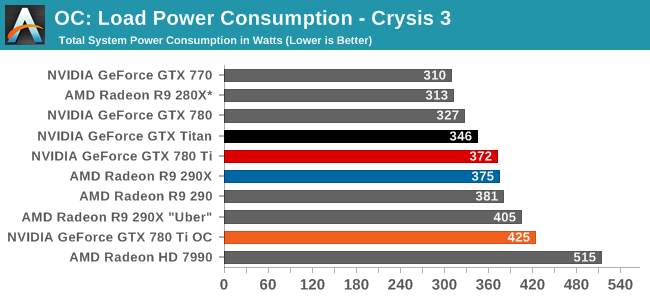
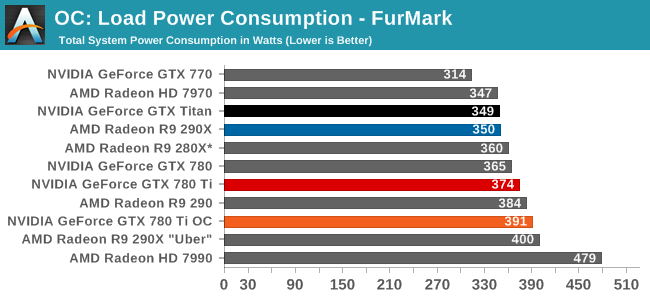
Starting as always with power, temperatures, and noise, we can see that overclocking GTX 780 Ti further increases its power consumption, and to roughly the same degree as what we’ve seen with GTX 780 and GTX Titan in the past. With a maximum TDP of just 106% (265W) the change isn’t so much that the card’s power limit has been significantly lifted – as indicated by FurMark – but rather raising the temperature limit virtually eliminates temperature throttling and as such allows the card to more frequently stay at its highest, most power hungry boost bins.
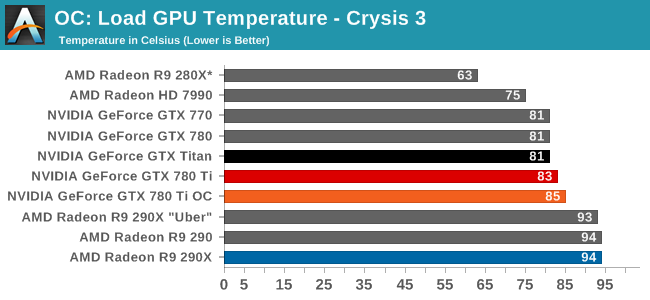

Despite the 95C temperature target we use for overclocking, the GTX 780 Ti finds its new equilibrium point at 85C. The fan will ramp up long before it allows us to get into the 90s.
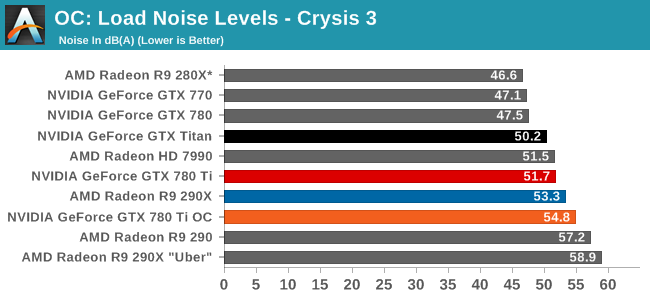
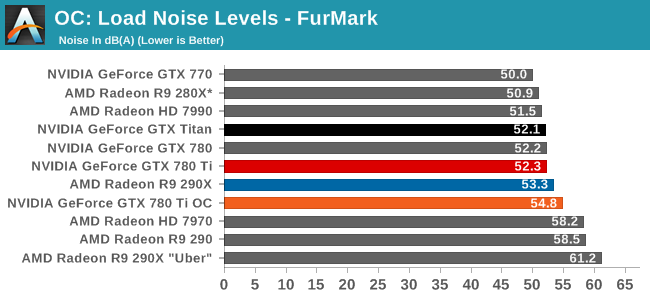
Given the power jump we saw with Crysis 3 the noise ramp up is surprisingly decent. A 3dB rise in noise is going to be noticeable, but even in these overclocked conditions it will avoid being an ear splitting change. To that end overclocking means we’re getting off of GK110’s standard noise efficiency curve just as it does for power, so the cost will almost always outpace the payoff on a relative basis.
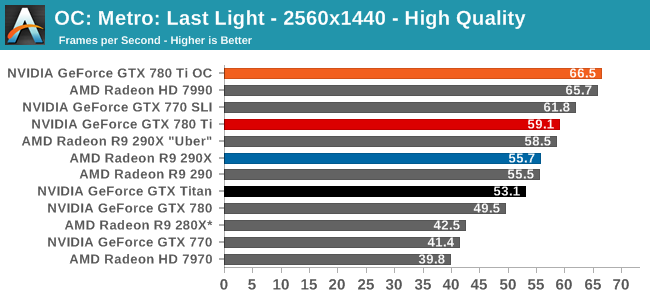
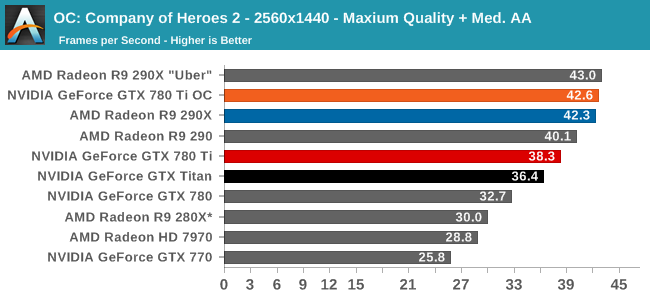
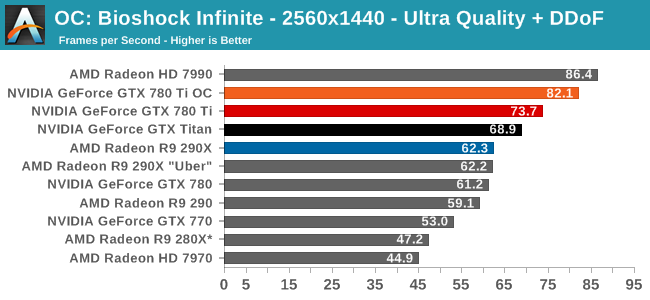
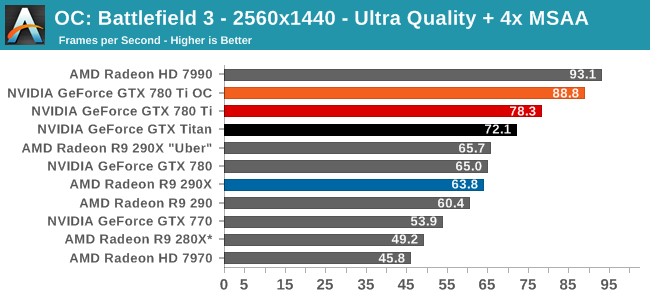
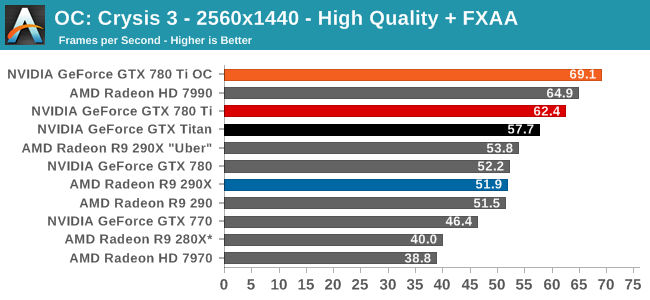
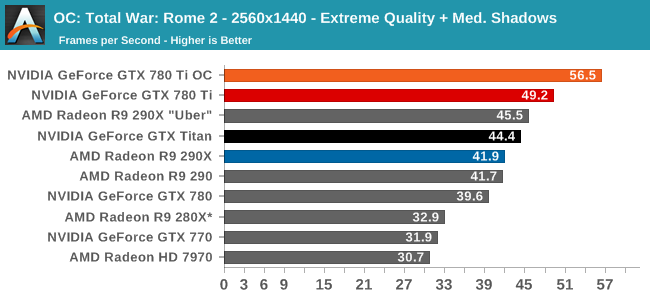
Finally, looking at gaming performance the the overall performance gains for overclocking are generally consistent. Between our 6 games we see a 10-14% performance increase, all in excess of the memory overclock and closely tracking the GPU overclock. GTX 780 Ti is already the fastest single-GPU card, so this only further improves its performance lead. But it does so while cutting into whatever is above it, be it the games where the stock 290X has a lead, or multi-GPU setups such as the 7990.










302 Comments
View All Comments
mohammadm5 - Monday, November 11, 2013 - link
http://www.aliexpress.com/item/Wholesale-Price-GeF...thats the wholesale price its not nvidia that charges so much is the resellers. the profit nvidia makes per gpu is very low but the reseller make alot of money, also the new amd r9 290 is going for $255 per unit at wholesale price and the r9 280x is going for $160 dollar per unit. you have to also remember thats the distributer price not the manufacturer price,witch should be alot lower. i know the gtx 780 at manufacturer price sells from $200 to $280 depending on brand.
so remember this is america were they sell you something made in china for 1 dollar for 10 dollars
UpSpin - Monday, November 11, 2013 - link
While those numbers are interesting, your conclusion is wrong. The $700 are what NVidia wants the customer to pay for the card, not what the reseller wants:http://nvidianews.nvidia.com/Releases/NVIDIA-Unvei...
"Pricing is expected to start at $699"
So it's not the seller who makes 100% profit, it's NVidia.
polaco - Monday, November 11, 2013 - link
remember that the reseller has to buy the card, pay import taxes, transportation and others, try to sell it and if the card goes unsold they have to sell it in a few month at discounts prices. Also in the case of psychical stores they have to keep building costs, employees, more taxes, etc. So what you are describing happens in every industry. Also and maybe in first place where are you getting those numbers from?Wade_Jensen - Monday, November 11, 2013 - link
OK, so either Brian has lost his Nexus 5 or its benchmark boosting, cause something has to be going on here.beck2448 - Monday, November 11, 2013 - link
Wow oc results are impressive. Where are the Lightning and Windforce versions?r13j13r13 - Tuesday, November 12, 2013 - link
la ventaja frente a una 290x es mínima pero la diferencias de precio no cuando se mejore la refrigeración de la 290x, al fin y al cabo la competencia nos beneficia a todosjukkie - Tuesday, November 12, 2013 - link
HD7990 can be gotten for as low as £400 in the UK at the moment (or £480 with a PSU or a M/B), so anyone wanting the ultimate in single CARD performance would bet better off buying that anyway.Obviously noise and heat will still be an issue, but if you're going to ignore the GTX 780 Ti's price, we can ignore those factors (thankfully microstuttering is mostly a non-issue these days since frame pacing has resolved that in everything except DX9 for now).
If the price of the 780 Ti were to drop 10-20%, I'd consider buying one, but as it is I simply can't justify it, even if affording it isn't a problem.
arjunp2085 - Wednesday, November 13, 2013 - link
Anand / RyanI would love to see a comparison of the 290 , 290x 780, 780 Ti with water coolers working efficiently. I believe that anyone spending $600 on a Gfx card would be able to spend an additional 100-200$ for a cool setup.
Further i would love to see if there is any performance increase due to increased cooling( With respect to boost states both Nv and AMD.
Any comments please let me know
Thanks,
Arjun
GUNN3R - Friday, November 29, 2013 - link
Is there an update in scores with latest drivers?Hrel - Sunday, January 12, 2014 - link
I really wish you guys had included useful resolutions. You realize the VAST majority of people, even enthusiasts, have 1080p screens right?You can do ur uber testing for your own personal concerns but it should be standing policy to include 1080p testing for everything. That's the resolution of screen that people have.